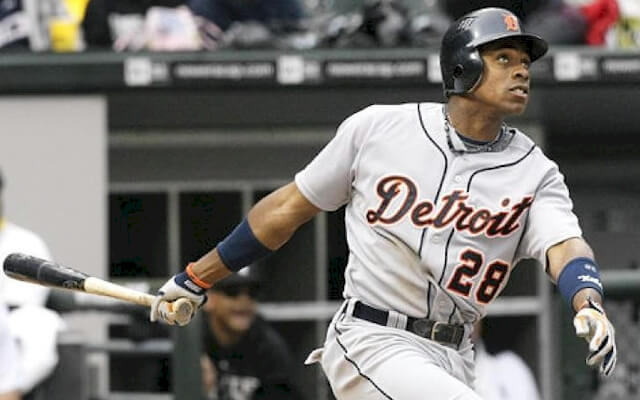
During his tenure with the Tigers from 2004 to 2009, as an outfielder and leadoff man, Curtis Granderson was a popular player.
Like the trades of Gee Walker in 1937 and Mickey Lolich in 1975, the deal that sent Curtis Granderson out of Detroit was immensely unpopular with Tiger fans, at least at first. That’s because Granderson was one of the most beloved players to ever wear the Old English D.
Why was Granderson so well-liked by teammates, his manager, and fans? There are at least four reasons: (1) he was humble, (2) he played hard, (3) he had a brilliant smile, and (4) he was talented. In six seasons in the Motor City, four as the starting center fielder for Jim Leyland, The Grandy Man was an All-Star once and in 2007 he finished tenth in American League Most Valuable Player voting.
That was the season when Granderson joined one of baseball’s most exclusive clubs. That year he tallied at least 20 doubles, triples, and home runs, a feat so rare only five previous players had accomplished it. That list includes Hall of Famers Jim Bottomley, Willie Mays, and George Brett. The Detroit center fielder legged out 23 triples in ’07, also stealing 26 bases, making him on of only four men to add that “20” to the trifecta.
Bottomley was known as “Sunny Jim” because of his positive disposition. That’s a nickname that would apply to Granderson, if it weren’t so antiquated of a term. The son of school teachers, Granderson possesses that cheery attitude you often find in the halls of junior and senior high schools. As a teammate, a player, a role model, Granderson was exemplary. He was so great with the media that there was already talk of a future in broadcasting when he was only three years into the league. He almost seemed like he was grateful that a sportswriter wanted to talk to him.
As Detroit’s leadoff man, Granderson had flaws. He didn’t walk enough for some critics, he didn’t get good jumps on the base paths (one year he only swiped 12 bases), and he struck out. He struck out a lot. But through that he was still beloved because of the base hits, the solid defense in center, the extra-bases, and the smile.
But back to the trade, the three-team, seven-player deal that shook up the winter meetings in 2009 and remade the Tiger roster. Detroit got young pitchers Max Scherzer and Daniel Schlereth from the Diamondbacks, and pitcher Phil Coke and outfielder Austin Jackson from the Yankees. But they lost Grandy, which was unacceptable to a lot of Tiger fans, especially female fans who loved their center fielder.
Ultimately, within a few years it became obvious that the trade was a great deal for the Tigers. Jackson was a better defender in center field, and adequate at the plate as a leadoff hitter. Coke was up-and-down but had a great stretch in the playoffs that led Detroit to the World Series in 2012. And Max Scherzer won the Cy Young and grew into one of the best starting pitchers in the game.
Tiger fans watched Granderson morph into a power hitter in Yankee Stadium, but most of them didn’t care that much because the team won four consecutive division titles without him. Twice, in 2011 and 2012, the Tigers matched up with Granderson and the Yanks in the playoffs, defeating them both times. In the 2012 ALCS, Detroit pitchers hung an 0-for-11 on Granderson in four games with seven strikeouts. People may have missed Granderson the man, but they were fine without Granderson the player as long as the team was winning.
During his time with the Yanks, Granderson earned two more All-Star nods and topped 40 homers twice. He later went across town to the Mets where he became one of a handful of hitters to slug 30 homers in a season for three different teams.
The 2017 season will be Granderson’s fourth in the National League and he’s only seven homers shy of the 300-mark. He’s in right field now, but he’s still a great teammate, still strikes out a lot, and he still has that engaging smile.


